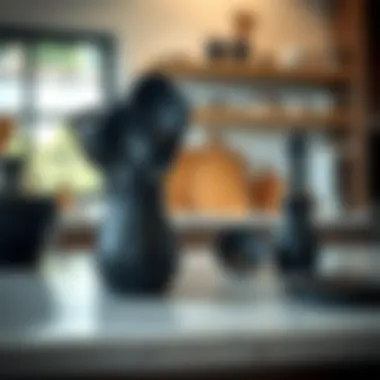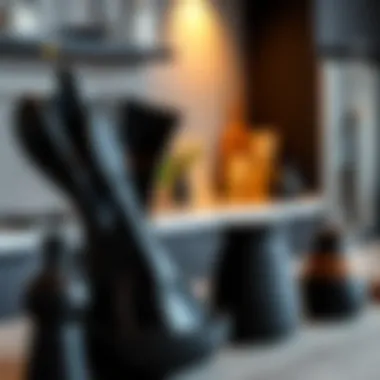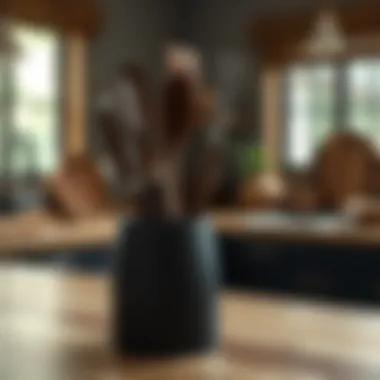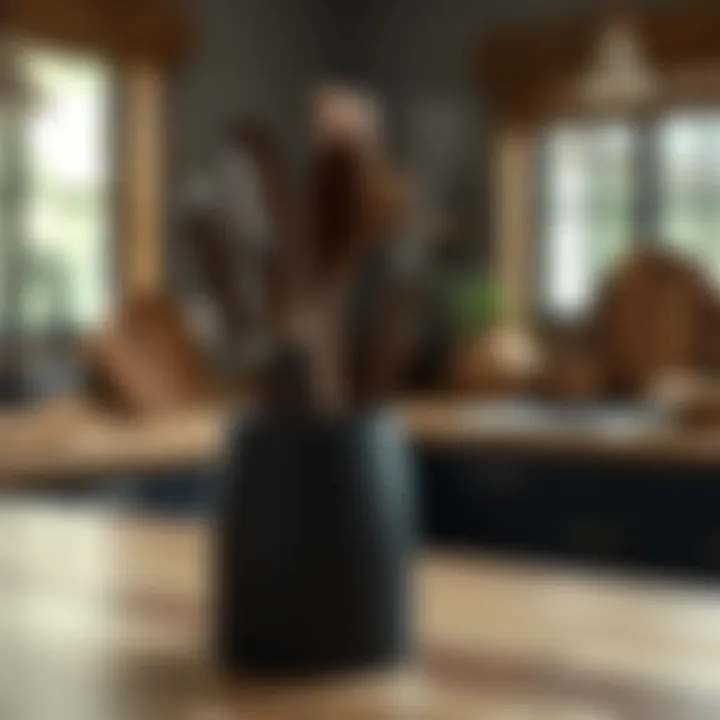The Allure and Functionality of Black Wooden Kitchen Utensils


Intro
Black wooden kitchen utensils offer more than just functionality; they bring a unique flair to culinary spaces. The rich tones of black wood exude elegance, while also serving as a testament to the relationship between aesthetics and practicality in the kitchen. Homeowners and culinary enthusiasts alike can find value not only in the visual appeal but also in the cultural heritage tied to these utensils. As households increasingly lean toward eco-friendliness, the allure of black wooden tools becomes stronger—not merely for their looks, but for their sustainable nature.
In this guide, we will explore various dimensions of black wooden kitchen utensils. From the material properties that contribute to their durability to their role in modern kitchen dynamics, readers will gain a comprehensive understanding of what makes these tools essential in any culinary collection. You'll discover maintenance techniques to ensure longevity and insights into design trends that highlight their charm. This exploration is aimed at inspiring homeowners, designers, and DIYers to incorporate black wooden utensils into their cooking spaces, transforming them into a blend of function and art.
Furniture Trends and Styles
Current Trends in Kitchen Design
In the realm of kitchen design, black enhances sophistication and provides a striking contrast against lighter elements. Homeowners are gravitating toward open-shelved layouts where black wooden utensils become a focal point, bringing warmth and depth. Such trends emphasize minimalism while integrating natural elements, making black wooden tools a smart choice.
Popular Styles and Their Characteristics
The emergence of various styles in kitchen design has elevated the status of black wooden utensils. Here’s a closer look:
- Modern Minimalism: Sleek lines and muted colors marry well with black wood, allowing utensils to blend in seamlessly while still standing out in a subtle way.
- Rustic Farmhouse: Here, the charm of black wooden utensils is highlighted against distressed cabinetry, bringing both functionality and an earthy aesthetic to the kitchen.
- Industrial Chic: With exposed pipes and metal elements, black wooden utensils serve as a perfect complement, contributing to a raw, unrefined elegance.
In today’s kitchens, black wooden utensils help convey a narrative. Their distinct appearance tells a story of quality and craftsmanship that resonates with those who appreciate the finer things.
Buying and Maintenance Guides
Essential Tips for Purchasing Black Wooden Utensils
When selecting utensils, consider the type of black wood used, as not all offer the same benefits:
- Density: Choose denser woods that resist wear and tear, like maple or oak, rather than lighter varieties.
- Finish: Look for a food-safe finish that enhances durability and color, keeping the utensils looking pristine longer.
- Design: Choose designs that feel comfortable in hand, as ergonomics play a role in usability.
Maintenance and Care for Black Wooden Utensils
To extend the life of black wooden utensils, proper maintenance is a key factor. Follow these simple guidelines:
- Hand Wash Only: Avoid dishwashers! Wash these utensils by hand using mild soap and warm water.
- Dry Thoroughly: Pat them dry to eliminate moisture, which can warp the wood over time.
- Oil Regularly: Applying food-grade mineral oil every few months helps maintain the finish and prevent cracking.
By adhering to these tips, black wooden kitchen utensils can remain a beautiful part of your kitchen for years to come, blending both form and function in an elegant dance.
"Investing in quality kitchen utensils not only enhances your cooking experience but also elevates your kitchen's aesthetic appeal."
To dive deeper into the topic of kitchen utensil care and products, consider exploring resources like Kitchen Design Trends or Sustainable Living Ideas.
So, whether you're a homeowner looking to spruce up your culinary space or a designer on the hunt for trendy yet functional tools, the world of black wooden kitchen utensils offers an abundance of choices that marry artistry and utility.
Intro to Black Wooden Kitchen Utensils
Black wooden kitchen utensils have been gaining traction in both home and professional kitchens alike. They stand not only as functional tools but also as elegant additions to kitchen decor. This has led many homeowners to embrace them, recognizing that these utensils offer a blend of aesthetic appeal and practical utility. Choosing black wooden utensils is like adding a touch of sophistication to everyday cooking tasks.
Definition and Overview
Black wooden kitchen utensils are typically crafted from high-quality hardwoods that have been finished to achieve a deep, rich color. These utensils include spatulas, spoons, ladles, and cutting boards, all made from wood that has either been stained or burned to create that striking black hue. Their smooth texture and stylish appearance enhance both the cooking experience and the visual allure of any kitchen setting.
Cultural Significance
Historical Background
The use of wooden kitchen utensils dates back centuries. In many cultures, wooden tools were favored for their durability and heat resistance, particularly in regions where metal items were scarce or expensive. The trend of using black wooden utensils can be traced to traditional practices where wood was often coated with natural oils or burnt to improve longevity and to add a layer of aesthetic appeal. This historical context not only adds depth to their usage today but highlights the craft and care that goes into making each piece. The keystone feature of this background is that such utensils are not mere tools but artifacts that tell stories of culinary traditions across generations, making them a longtime staple respected in kitchens worldwide.
Regional Variations
Different cultures around the globe have adopted black wooden utensils in unique ways that reflect their local customs and resources. In Scandinavian countries, for instance, you might find utensils made from locally sourced birchwood, while in Asia, bamboo may be favored for its lightweight and flexible qualities. Each region's choice emphasizes their practical considerations and adds a distinct character to their kitchen look. What makes black wooden utensils appealing is their versatility across these various cultures; they satisfy aesthetic sensibilities while continuing to serve core functions. This cultural tapestry reveals how the same basic item can morph and adapt based on local practices, challenges, and available materials.
In summary, black wooden kitchen utensils embody a rich history and diverse cultural significance. They have anchored kitchens across time, offering not just functionality but also a glimpse into the culinary customs of various regions. Their continued popularity today is testament to their importance in both practical cooking and kitchen decor.
Material Considerations
When it comes to black wooden kitchen utensils, the material they are crafted from plays an essential role in their functionality and aesthetic quality. A deep understanding of the materials involved not only informs consumers about their longevity but also speaks volumes about their environmental impact and overall craftsmanship. The right wood choice, along with specific finishing techniques, can enhance the visual appeal while ensuring the utensils remain practical for everyday use.
Types of Wood Used
Maple
Maple wood, often celebrated for its fine grain and light color, has a unique aspect that makes it a strong contender for kitchen utensils: its density. It holds up well against wear and tear, making it an ideal choice for items like spatulas and spoons. One key characteristic of maple is its ability to resist staining, which is a beneficial trait for any kitchen item that’s regularly in contact with food.
Unique Feature: What sets maple apart is its tight grain structure. This feature not only adds to its beauty but also enhances its durability. However, due to its lighter color, maple may not always maintain the desired black hue without additional finishing treatments.
Oak


Oak wood is renowned for its strength and resilience. Its unique characteristic is the pronounced grain that runs through each piece, giving it a rustic yet elegant appearance. Oak’s robust nature makes it a great choice for larger utensils like cutting boards or heavy-duty spoons, which may undergo more significant stress during use.
Important Note: A downside of oak is its porous nature. This can sometimes lead to absorbing moisture or odors if not properly finished, which could affect flavors in cooking. However, with the right stain, oak can beautifully complement a black wooden kitchen aesthetic while maintaining its functional integrity.
Walnut
Walnut is often regarded as the crème de la crème of wooden kitchen utensils. Its rich, dark tones and striking grain patterns contribute significantly to its appeal. Walnut’s density makes it sturdy enough to withstand daily use, while its natural oils provide a level of moisture resistance that is advantageous for kitchen settings.
Key Characteristic: The natural dark color of walnut lends itself to the black wooden theme beautifully, often requiring less artificial treatment to achieve a desired finish. However, it is typically more expensive than both maple and oak, making budgeting a crucial factor for some consumers.
Finishing Techniques
Oiling
Oiling involves applying natural oils to the wood surface, which penetrates the wooden fibers and enhances its longevity. Oiling is particularly beneficial as it not only nourishes the wood but also helps repel water and stains, making it a practical choice for kitchen utensils.
Why It’s Beneficial: Regular oil application keeps the utensils looking fresh and prevents them from drying out or cracking.
Staining
Staining is a technique that adds color to the wood surface while preserving the natural grain. This process is significant for achieving that rich black hue associated with high-quality kitchen utensils. Staining allows for customization, making it a popular choice among homeowners looking to match their kitchen decor.
Consideration: It’s worth noting that some stains may not be as food-safe, so it’s essential to choose products specifically designed for kitchen use.
Sealing
Sealing involves coating the wooden surface with varnish or a sealant, providing a durable barrier against moisture. This technique is crucial for utensils that come into contact with food, as it helps prevent the absorption of bacteria and odors.
Unique Feature: A well-sealed utensil can last for years, maintaining its appearance and functionality. However, over time, the seal might need to be reapplied to ensure continued effectiveness.
Aesthetic Appeal
The aesthetic appeal of black wooden kitchen utensils plays a vital role in both functionality and visual intrigue within the culinary space. As kitchens evolve into open-concept living areas, the utensils we choose are no longer just tools; they are also design elements that enhance the overall atmosphere of the kitchen. This section explores some intricate layers of this appeal by examining visual characteristics and the integration of these utensils in various home design themes.
Visual Characteristics
Texture
Texture serves as one of the most engaging aspects of black wooden kitchen utensils. The feeling of the material in hand creates a sensory experience that isn't just for cooking but also for aesthetics. Black wooden utensils often feature a smooth finish, which can be particularly appealing while handling or serving food. This smoothness isn’t just visually satisfying; it adds a subtle elegance to everyday tasks.
A key characteristic of the texture of black wood is its natural grain patterns, which can vary significantly from piece to piece. This uniqueness makes each utensil a conversation starter, drawing attention on its own merit. It’s a standout characteristic that fosters a connection between the user and the object.
The downside, if one might call it so, could be that certain textures may show wear over time, leading to questions about durability. However, the allure that these textures bring often outweighs such concerns, as they encourage homeowners to engage more thoughtfully with their kitchen tools.
Color Variations
Color variations in black wooden kitchen utensils extend beyond mere aesthetics; they embody the essence of design flexibility. The rich, dark hue of black wood acts as a neutral base, which allows these utensils to seamlessly blend into various color schemes and design philosophies, whether they be vibrant or subdued. The variations can be a result of different wood species or techniques used during the finishing process, leading to a spectrum that may range from deep ebony to softer charcoals.
Black wooden utensils at home often pop against lighter backgrounds, adding contrast and depth to the culinary environment. In this light, the versatility of color is one of the strongest selling points for such utensils. However, the purification of the hue can sometimes lead to concerns about matching materials. Still, the visual impact created often compensates for these concerns, enhancing the rest of the kitchen decor.
Integration in Home Design
Minimalist Kitchens
In a minimalist kitchen, every object serves a purpose. This design ethos emphasizes simplicity and functionality, making black wooden utensils an ideal choice. The elegance of their form coupled with the understated sophistication of the color aligns perfectly with the minimalist philosophy.
A striking feature of minimalist kitchens is their lack of clutter, and having sleek, monochromatic utensils can enhance this quality. They subtly enhance the environment without overwhelming it, allowing for a serene cooking experience. Yet one must be cautious; while they charm the eye, if the utensils aren’t cared for properly, the sleekness can lose luster, potentially affecting the minimal aesthetic.
Rustic Themes
On the flip side, black wooden kitchen utensils can also find a home in rustic-themed kitchens, where warmth and charm are paramount. The natural characteristics of wood align beautifully with rustic elements like exposed beams and farmhouse tables. Here, black wooden utensils offer a bold contrast against warm, earthy tones that are usual in rustic settings. Their tactile nature can evoke feelings of tradition and homeliness, appealing to those who cherish vintage charm.
However, in a rustic thematic setup, one potential drawback is that certain dark hues might tend to absorb kitchen lighting, creating a shadowy effect that may not be flattering in every setting. This consideration calls for smart placement and lighting choices to maximize the inherent beauty of these utensils in such environments.
"Black wooden kitchen utensils are not just tools; they are pieces of art that reflect the user's personality and aesthetic choices."
Functional Benefits
When discussing black wooden kitchen utensils, it’s vital to address their functional benefits comprehensively. These utensils aren't merely stylish; they serve distinct purposes that enhance the overall cooking and eating experience. Emphasizing practicality alongside aesthetics ensures that homeowners and culinary enthusiasts can make informed choices.
Heat Resistance
One significant advantage of black wooden utensils is their impressive heat resistance. Unlike plastic tools that can warp or melt, wooden utensils withstand higher temperatures without compromising their integrity. This quality makes them ideal for stirring hot soups or sautéing vegetables without the risk of damage. Furthermore, the insulated nature of wood prevents burns, providing cooks with a more comfortable grip even when handling hot dishes.
Using black wooden utensils means freedom from conducting heat, which can be a real game changer when your pan is sizzling. This characteristic also prevents any unwanted reactions with acidic foods, ensuring that your sauces taste just as they should. The added longevity offered by heat resistance features heavily in discussions about kitchen tool choices, as they can remain in good condition for many years—extending their overall usage.


Durability and Longevity
Care Practices
When it comes to the durability of black wooden kitchen utensils, care practices stand out significantly. Proper care prolongs the life of these kitchen essentials, ensuring that they remain functional and aesthetically pleasing long-term. Regularly washing them by hand rather than tossing them in the dishwasher is a common recommendation, as dishwashers can expose wood to excessive moisture and heat that can lead to warping.
The characteristic of being easy to maintain makes black wooden utensils a popular choice. They can be wiped down quickly and often only need occasional oiling to keep them looking their best. One unique feature is the use of food-grade mineral oil, which helps maintain moisture levels within the wood, preventing cracking and splitting. This simple maintenance routine provides countless benefits, making them a favorite among home cooks who value longevity.
Replacement Cycles
Understanding the concept of replacement cycles enhances appreciation for black wooden kitchen utensils. While they are designed for durability, all utensils require replacement at some point. Black wooden tools can last several years if cared for properly, which makes them a good investment. One critical characteristic is that they are often made from dense hardwoods, giving them an edge over lower quality alternatives.
Homeowners can optimize their replacement cycle by keeping an eye on signs of wear, such as splintering or discoloration. By doing so, they can replace utensils before they become unusable, thus ensuring the ongoing quality of their kitchen tools. In this way, the black wooden utensils stand out as a practical choice, balancing the fine line between aesthetic appeal and functional longevity.
In summary, when evaluating kitchen utensils, the functional benefits of heat resistance, durability, and the proper care practices coupled with logical replacement cycles cannot be overlooked. These features contribute to a kitchen environment that's not only beautiful but also functional and reliable.
Environmental Impact
The selection of kitchen utensils is not merely about aesthetics or functionality; it deeply intertwines with our responsibility toward the environment. The production and sourcing of materials can leave a significant mark on our surroundings. Black wooden kitchen utensils, particularly those made from sustainably sourced wood, hold the potential to cultivate a more eco-friendly kitchen. Understanding the environmental impact of these items can guide consumers towards more conscientious choices.
Sustainable Sourcing
Forestry Practices
Sustainable forestry practices stand at the forefront of ensuring that the wood used in utensils does not deplete forest resources or harm the ecosystem. These practices emphasize the importance of managing forests in a way that meets current needs without compromising the future. One significant aspect of sustainable forestry is the selective logging method, where only certain trees are harvested, leaving the forest canopy intact. This promotes biodiversity and prevents soil erosion.
Here are a few key characteristics of sustainable forestry:
- Renewable Resources: The focus is on renewable tree species that regenerate over time.
- Biodiversity Preservation: Practices aim to maintain the natural habitat for wildlife, allowing them to thrive alongside the logging activities.
- Atmospheric Benefits: Healthy forests play a crucial role in carbon sequestration, helping to mitigate climate change.
While choosing utensils crafted from wood sourced through these practices can be a beneficial decision, it's essential for consumers to remain vigilant. Ill-informed purchases may contribute to deforestation, particularly concerning exotic woods. Hence, paying attention to sourcing is paramount in aligning with sustainable practices.
Certifications
Certifications provide an additional layer of assurance that the wood used in kitchen utensils adheres to specific environmental standards. Various organizations, such as the Forest Stewardship Council (FSC) and the Programme for the Endorsement of Forest Certification (PEFC), offer certifications that guarantee responsible forestry practices.
Key characteristics of certifications include:
- Transparency: Certified products come with documentation to trace their sourcing back to responsible practices.
- Consumer Assurance: Certifications enable consumers to make informed choices, supporting producers who uphold environmental integrity.
- Market Demand: Products with such certifications often enjoy a preference among eco-conscious consumers, encouraging more businesses to adopt sustainable measures.
While certifications enhance consumer knowledge, there can be some confusion arising from various labels on the market. Often, not all certifications hold the same weight. Therefore, it is wise for consumers to familiarize themselves with reputable certification bodies to avoid misled satisfication.
Biodegradability
The recycling potential and biodegradability of wooden kitchen utensils cannot be overstated. Wood, a natural material, breaks down organically over time, unlike plastic or metal alternatives. When disposed of correctly, these utensils can return nutrients back into the soil, promoting plant life.
One notable aspect of this is that wooden utensils do not contribute to the growing problem of plastic waste, which plagues our environment. As more consumers opt for biodegradable alternatives, this movement encourages a healthier ecosystem. However, it's imperative to ensure that the utensils are free from non-biodegradable coatings or chemicals, which could hinder the breakdown process.
By being mindful of these elements, individuals can make daily decisions that support environmental sustainability. From mindful purchasing to responsible disposal, every little bit helps our planet. As we explore black wooden kitchen utensils, it becomes clear that selecting these tools may positively impact our everyday cooking experiences, blending practicality with ecological consciousness.
Trends in Kitchen Utensils
The world of kitchen utensils is not just about functionality. It's a reflection of evolving tastes, habits, and lifestyles. Understanding trends in kitchen utensils, particularly in the context of black wooden options, allows homeowners and culinary enthusiasts to make informed decisions that suit both their aesthetic and practical needs. Keeping these trends in mind can lead to a more harmonious kitchen environment, where every tool is not only useful but also adds to the overall atmosphere.
Current Design Trends
Monochromatic Styles
Monochromatic styles have gained popularity for their sophistication and simplicity. When applied to black wooden kitchen utensils, this trend emphasizes a uniform color palette that can seamlessly integrate into various kitchen designs. The key characteristic of monochromatic styles is their ability to blend effortlessly with both modern and traditional decor, offering a streamlined look that many find appealing.
The unique feature of this approach lies in its versatility. A black wooden spoon or spatula, for example, can look stunning against any backdrop, whether set against a bright countertop or a subtle wood grain finish. This not only enhances the visual appeal but also adds an element of elegance. However, a potential disadvantage might be the perception that monochromatic styles can appear too stark or cold if not balanced with other design elements.
Handmade Customization
In contrast, handmade customization is increasingly sought after for its personal touch and uniqueness. Each piece crafted by hand embodies a story, reflecting the artisan's creativity and the owner's personal taste. The key characteristic here is that every item is distinct, which adds a layer of individuality that mass-produced utensils simply cannot offer.
One unique feature of handmade black wooden utensils is the variety of finishes and designs available, ranging from minimalistic styles to intricately carved patterns. This customization is an attractive choice for those looking to invest in utensils that are not just functional but also serve as artful statements in the kitchen. However, a notable downside might be the cost and availability, as handcrafted items can often command a premium price and may not be as readily available as their factory-made counterparts.
Market Preferences
Shifts in market preferences are vital for understanding consumer behavior in the kitchen utensil segment. As more people become conscious of sustainability and lifestyle choices, there's been a noticeable preference for products that don't just serve a purpose but also align with eco-friendly principles. Black wooden utensils made from responsibly sourced materials are increasingly favored for their minimal ecological footprint, marrying practicality with principles.
Homeowners and designers should pay attention to these trends, as they not only influence purchasing decisions but also affect how kitchens are designed and experienced. Switching to sustainable materials like black wood can not only elevate the aesthetic of a kitchen but also resonate with a growing consumer base that prioritizes eco-conscious living.
"Incorporating trending kitchen utensils is more than just a design choice; it's a reflection of values and a way to create a sanctuary reflecting one’s personal and environmental beliefs."


By acknowledging and adapting to these trends, homeowners can cultivate their kitchens as inviting spaces that showcase both style and care for the environment.
Maintenance and Care
The longevity of black wooden kitchen utensils heavily relies on proper maintenance and care. Just like a well-tuned instrument, these tools require attention to keep them performing beautifully in the kitchen. Here, we delve into specific cleaning methods and long-term preservation strategies that not only enhance the lifespan of these utensils but also their aesthetic appeal.
Cleaning Methods
Keeping your black wooden kitchen utensils clean ensures they remain not just functional but also visually inviting. Let's break down two fundamental cleaning approaches:
Hand Washing
Hand washing emerges as a prominent choice when it comes to cleaning black wooden utensils. Unlike throwing them in a dishwasher, which can lead to warping and cracking, hand washing guarantees a gentler yet effective cleaning process. The key characteristic of hand washing is the careful attention it provides, allowing for thorough scrubbing without the perils of extreme heat or harsh jets of water.
The unique feature of this method rests in using mild soap and warm water. Not only does this prevent any potential damage, but it also retains the wood’s natural sheen. One of the advantages here is that it allows you to inspect your utensils closely for any signs of wear or damage.
Avoiding Harsh Chemicals
In tandem with hand washing, avoiding harsh chemicals is crucial in the upkeep of black wooden kitchen utensils. Many household cleaners contain bleach and abrasive components, which can strip away the natural oils of the wood. This approach emphasizes a key characteristic — the preservation of the wood’s integrity and finish.
By steering clear of harsh chemicals, you ultimately prolong the lifespan of your utensils. The unique aspect of this consideration is the use of natural cleaners, such as vinegar or baking soda, which are much gentler. In terms of advantages, this not only protects your utensils but also ensures food safety, reducing the risk of chemical contamination.
Long-Term Preservation
To keep your black wooden utensils looking sharp through the years, long-term preservation methods are paramount. Here we discuss two essential practices:
Oil Application
Applying oil to your black wooden kitchen utensils has become a well-regarded technique for preserving their beauty and functionality. The specific aspect of oil application is its role in replenishing the natural oils that may deplete over time from regular use. A key characteristic of this process is the enhancement of the grain and color of the wood, making it look brand new.
The unique feature of using food-grade mineral oil or specialized wood oils nourishes the wood, preventing cracks and splinters. One advantage of this method is that it creates a protective barrier against moisture, effectively reducing the risk of bacterial growth. However, it’s important to apply oil at intervals that suit your usage frequency; for frequently used utensils, a monthly oiling might be ideal.
Storage Solutions
Finding the right storage solutions is also critical for the preservation of black wooden kitchen utensils. The specific aspect here involves maintaining a dry and well-ventilated space to prevent moisture buildup which can lead to mold and decay. A key characteristic of optimal storage is using a designated pot or holder, rather than tossing utensils into a drawer.
This approach also has a unique feature: it makes your utensils easily accessible and showcases their aesthetic appeal as part of your kitchen décor. Among the advantages of well-thought-out storage solutions is that they protect your utensils from collisions and scratches, ensuring they remain in tip-top shape for years.
In summary, maintaining the beauty and functionality of your black wooden kitchen utensils is no small feat, but with proper cleaning methods and preservation techniques, they can last a lifetime.
DIY and Customization Options
When it comes to kitchen utensils, individuality can truly shine through DIY projects and customization options. Black wooden utensils are not just functional items but also embodiments of style that can reflect the personality of a homeowner. The importance of exploring DIY and customization options lies in the ability to create tools that not only suit individual tastes but also enhance the kitchen environment, making it more inviting and unique.
One major benefit of designing your own wooden kitchen tools is the opportunity to incorporate personal flair. This can instill a sense of pride as you craft items that are exclusively yours. Additionally, making your own utensils can be cost-effective—if you're handy with a few tools and have a penchant for creativity, you can create beautiful pieces without breaking the bank.
Customization further allows for the consideration of specific functional needs, whether that means crafting a large stirring spoon or a set of smaller serving spoons. Each piece can be tailored to complement the specific dishes or cooking techniques that define your culinary style.
Tools Required
For anyone inclined to delve into the world of DIY wooden kitchen utensils, having the right tools is crucial. Below is a concise list of essential tools you will need prior to embarking on this creative journey:
- Wood (Choose your preferred type—maple, walnut, etc.)
- Woodworking Knife or Carving Tools
- Sandpaper (Various grits for smoothing surfaces)
- Wood Finish (Food-safe options like mineral oil or beeswax)
- Clamps
- Measuring Tools (Ruler or tape)
- Pencil (For marking your cuts)
Having these tools on hand makes it easier to craft a range of utensils and explore your creativity fully.
Step-by-Step Guide
Creating your own black wooden kitchen utensils might seem daunting, but following a simple step-by-step guide can ease the process and lead you to stunning results. Here’s how to bring your ideas to fruition:
- Select your wood: Choose the type of wood you want for your utensils—a hardwood like oak or walnut generally works best.
- Sketch your designs: Draw out your intended shapes on paper, ensuring that you know precisely how your finished piece will look.
- Measure and mark: With a ruler and pencil, measure the lengths and widths accurately on the wood.
- Cut the wood: Use a saw to cut along the marked lines if you're making larger utensils. For smaller pieces, a carving knife may suffice.
- Shape your utensil: Carve and shape your wood pieces using your knife or other carving tools. This step lets you create the contours of your spoon or spatula.
- Sand down rough edges: Take the sandpaper and smooth out any rough spots, ensuring a nice finish that won’t splinter during use.
- Finish with oil: Apply a food-safe finish to protect and enhance the color of the wood. This step is crucial for maintaining the utensil's longevity and aesthetic appeal.
- Let it dry: Allow your utensil to air dry thoroughly before putting it to use. This ensures that the oil penetrates properly and the piece is ready for the kitchen.
Creating your own utensils not only personalizes your kitchen but also allows a deeper appreciation of craftsmanship and functionality in everyday tools.
These steps engage both the hands and the mind, facilitating a meditative experience while also yielding functional artistry. In a world where mass production often overshadows individuality, making your own utensils can become a satisfying venture of creativity and utility.
Epilogue
Black wooden kitchen utensils embody a unique blend of functional reliability and aesthetic charm, making them an essential consideration for any culinary space. Their significance goes beyond mere utility; these utensils are crafted from natural materials and hold cultural importance in various regions, reflecting local craftsmanship and traditional practices. This guide has navigated the multifaceted aspects of black wooden kitchen tools, illuminating their durability, care practices, and their stylish fit in today’s home designs.
Summarizing Key Points
In summarizing, there are several notable features about black wooden kitchen utensils that stand out:
- Material Varieties: Black kitchen utensils are crafted from a range of durable woods, each offering distinct qualities. Walnut provides a rich hue, while oak is known for its sturdiness, and maple is lightweight and smooth to the touch.
- Aesthetic Appeal: These utensils are not just tools; they are art pieces that can enhance kitchen decor. Their darker tones often complement modern and rustic themes, giving a polished or homey vibe to any kitchen setting.
- Sustainability: As homeowners increasingly consider their ecological footprint, the sustainable sourcing of the wood used in these lassic tools is crucial. Understanding forestry practices ensures that the utensils are both functional and environmentally friendly.
- Maintaining Quality: Proper care and maintenance practices, such as regular oiling and thoughtful storage, prolong the life of these utensils, making them a worthy investment for any chef or cooking enthusiast.
Future Trends in Kitchen Utensils
Looking forward, several emerging trends can shape the future of black wooden kitchen utensils:
- Focus on Eco-Friendly Products: As consumers become more environmentally conscious, there will likely be an increased demand for kitchen tools sourced from sustainably managed forests. This could lead to more certifications and labels that highlight ecological responsibility.
- Customization and Personalization: The rise of DIY culture means homeowners are keen on customizing their kitchen tools. Black wooden utensils can be personalized with engravings or distinct finishes, making them unique kitchen companions.
- Integration of Technology: Innovative designs may combine traditional wooden materials with modern technology. For instance, utensils that provide feedback on temperature or moisture levels in cooking could become increasingly popular.
- Collaborative Crafting: Expect collaborations between designers and artisans to flourish, leading to limited-edition releases of handcrafted utensils that emphasize a blend of style and tradition.
In essence, the journey through the realm of black wooden kitchen utensils reveals their significance and the responsibilities associated with their usage. As we move forward, blending tradition with innovation will enhance both the function and experience of cooking at home.







